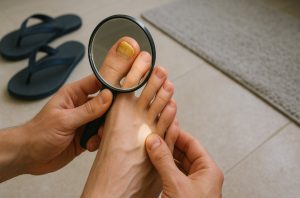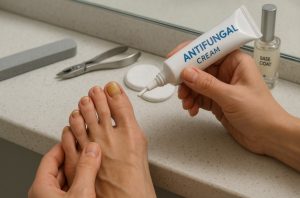Have you recently looked down at your feet and noticed that your toenails have turned yellow? Are you wondering whether this change is harmless or something to be concerned about?
Yellow toenails are surprisingly common, and the reasons behind them can range from simple staining to more complex medical conditions. Understanding the root cause is important not only for your nail health but also for your overall wellbeing.
Could a Fungal Infection Be the Reason?

A fungal infection is the most common explanation for yellow toenails. The condition, medically referred to as onychomycosis, usually begins with a small white or yellowish spot beneath the nail tip. Over time, this infection can spread deeper, leading to more visible symptoms.
The nail may start to thicken, become brittle, and even lift from the nail bed. In some cases, it may emit an unpleasant odour.
Fungi thrive in warm, damp environments, which is why infections often develop after frequenting communal areas like gyms, swimming pools, or locker rooms.
If left untreated, fungal infections can become stubborn and may require both topical and oral antifungal treatments.
Have You Experienced Any Recent Nail Trauma?
Physical trauma or repetitive pressure on the toenail can also lead to yellowing. Injuries to the nail whether from accidentally stubbing your toe, wearing tight shoes, or participating in high-impact sports can damage the nail bed and cause internal bruising or bleeding.
As the nail recovers, the trapped blood and debris underneath may turn the nail yellow or brown.
This form of yellowing is often limited to one nail and doesn’t spread to others. Unlike fungal infections, trauma-related discoloration usually resolves on its own as the nail grows out, provided no further injury occurs.
However, if you see signs of pain, swelling, or infection, it’s best to have it evaluated by a healthcare professional.
Are Any Medical Conditions Causing the Discoloration?
Sometimes, yellow nails are not a result of infections or trauma but are instead linked to broader health issues.
Various underlying conditions can affect the health, appearance, and colour of your toenails. Here is a comparison of conditions and their potential impact on your nails:
| Medical Condition | How It May Affect the Nails |
| Hypothyroidism | Nails may grow slowly, become thick, and develop a yellow tone |
| Psoriasis | May cause pitting, detachment, and yellow-brown discolouration. |
| Liver Disease (Jaundice) | Can result in yellowing of both skin and nails due to bilirubin buildup |
| Diabetes | Leads to poor circulation, making nails more prone to infection and discolouration |
| Lung Disease | Often linked with Yellow Nail Syndrome and visible thickening |
If you are living with any of these health conditions and notice changes in your toenails, it may be worth discussing the symptoms with your doctor.
In some cases, yellow nails can be an early indicator of a flare-up or a complication that needs attention.
What Is Yellow Nail Syndrome and Should You Be Concerned?

Yellow Nail Syndrome is a rare but important condition that affects both fingernails and toenails. It’s characterised by a distinct set of symptoms, which usually includes slow-growing, thickened, yellow nails.
The condition is often accompanied by swelling in the limbs (lymphedema) and chronic respiratory problems, such as persistent cough or fluid in the lungs.
The syndrome is typically seen in adults and may be associated with other medical conditions including bronchiectasis or pleural effusion.
The cause isn’t always clear, but the nail changes are often the most visible sign. If you have nail discolouration along with breathing problems or swelling in your legs or arms, you should seek medical advice promptly.
Can Nail Polish Be the Cause of Yellow Toenails?
If you’re someone who frequently wears nail polish particularly darker shades such as red, orange, or yellow, it’s entirely possible that your yellow toenails are simply stained.
The pigments used in nail varnish can seep into the keratin of the nail over time, especially if you don’t use a protective base coat.
This kind of yellowing is superficial and not a sign of disease. It often fades naturally as the stained portion grows out.
If you’re concerned about staining, taking regular breaks from nail polish and applying clear base coats before coloured ones can help prevent future discolouration.
Is the Yellowing Related to Age or Nutrition?

Ageing naturally affects the structure and appearance of toenails. As people get older, nails tend to become thicker and more brittle and may develop a yellow tint even in the absence of infection or trauma. This is due to changes in blood flow and nail cell regeneration.
In addition, nutritional deficiencies may play a role. Vitamins A and C are particularly important for maintaining healthy nails. A lack of these nutrients could lead to discolouration, thinning, or slow nail growth.
Poor dietary habits or underlying gastrointestinal issues that impair nutrient absorption could contribute to such deficiencies.
Could Everyday Habits Like Cooking With Turmeric Be Responsible?
While it may sound surprising, turmeric, a popular spice used in many households, can stain your nails if handled frequently.
The bright yellow pigment in turmeric easily transfers to skin and nails and can be stubborn to remove. This kind of yellowing is harmless and can usually be faded with regular handwashing and gentle scrubbing.
If you cook with turmeric often and notice yellow nails, wearing gloves or using utensils to handle it directly can help prevent stains in the future.
When Should You Seek Medical Advice for Yellow Toenails?
It’s not always easy to determine whether yellow toenails are cause for concern. However, certain signs should prompt you to seek medical evaluation.
If the discolouration is persistent, getting worse, or spreading to other nails, it could indicate an underlying problem. Thickening, brittleness, crumbling, or detachment from the nail bed are all symptoms that warrant further investigation.
You should also consult a healthcare provider if you experience any pain, foul odour, or signs of infection, especially if you have an existing condition like diabetes, poor circulation, or a weakened immune system.
A professional can perform tests, including fungal cultures or blood work, to determine the exact cause and recommend appropriate treatment.
What Are the Best Treatment Options for Yellow Toenails?

The treatment for yellow toenails depends entirely on the underlying cause. If a fungal infection is diagnosed, treatment may include antifungal creams, medicated nail lacquers, or oral antifungal tablets.
For trauma-induced yellowing, protecting the nail and allowing time for it to grow out is usually sufficient.
If staining from nail polish is the culprit, taking a break from coloured varnish and using nail-strengthening treatments can help. In cases related to systemic health issues, addressing the underlying condition is key to improving nail appearance.
Proper foot hygiene, well-fitting shoes, and regular inspection of your toenails are all helpful preventative measures.
If your toenails have changed in colour, texture, or shape and you’re unsure why, the safest course of action is always to consult a medical professional.
FAQs About Yellow Toenails
What is the most common cause of yellow toenails?
The most common cause is a fungal infection called onychomycosis, which can lead to thick, discoloured, and brittle nails.
Can nail polish turn my toenails yellow?
Yes, frequent use of dark-coloured nail polish without a base coat can stain the nails yellow.
Is yellowing of toenails always a medical concern?
Not always. It can be due to external staining, ageing, or trauma, but persistent yellowing should be checked by a doctor.
How do I know if the yellowing is due to a fungus?
If the nail is also thickened, crumbly, or lifting from the nail bed, a fungal infection is likely.
Can vitamin deficiency cause yellow toenails?
Yes, deficiencies in vitamins like A and C may contribute to nail discolouration and poor nail health.
What is Yellow Nail Syndrome?
It’s a rare condition involving yellow nails, swelling (lymphedema), and respiratory problems.
When should I see a doctor about yellow toenails?
If the discolouration is worsening, spreading, painful, or accompanied by other symptoms, seek medical advice.






